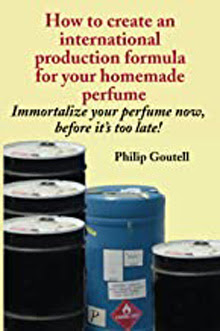Monday, June 8, 2009
The costs involved in making your own perfume
Everyone knows that when you buy a bottle of perfume at retail, most of what you are paying goes into advertising expense and profit. The bottle and packaging have SOME costs associated with them but the fragrance itself? Why THAT costs almost nothing! That is, if you are a BIG perfume company.
I recently had the opportunity to discuss costs with a friend and business associate who is also the source of my own perfumery raw materials. I'm going to speak a little in general terms here as some of what I'm writing about is a bit confidential. And also, I don't want to destroy the "mystique" of perfume which is what helps us all make money.
I know from personal experience that it is not easy to find suppliers who will sell the raw materials of perfumery in small quantities to people like myself. For example, if I want Lyral -- a beautiful lily of the valley aroma chemical made by IFF in New Jersey -- I can buy it directly from IFF at a very good price ... if I am willing to take a DRUM.
But Lyral may be only one of 100 raw materials I need. My office doesn't have room for 100 DRUMS of aroma chemicals, nor do I have the MONEY to buy that much, nor would I have the equipment necessary to TRANSFER chemicals out of drums and into smaller containers.
Realistically, when I am working on a new fragrance, I might only want 20 or 30 GRAMS of each aroma material I am using, which would be a "sample" quantity for a company like IFF. The big fragrance companies WILL send samples to customers -- "customers" meaning companies that will ultimately buy by the drum. And -- irony -- speaking to a chemist for a major U.S. household products company, he complained that when his company made a sample request, the fragrance houses sent them a LARGER sample than they really wanted because their need in developing a product wasn't much bigger than my own but, while I hoard any aroma materials I can get my hands on, this giant company DOES NOT keep a "library" of fragrances and has to DISPOSE of what is left over from their experiments using VERY STRICT AND EXPENSIVE techniques to safeguard the environment.
So back to making perfume. In need of smaller quantities of aroma materials, I have a limited choice of sources. And to get what I need, I have to go to a source who buys from ANOTHER source who may buy from a THIRD source who buys it directly from the manufacturer or processor.
Let me do that again, in reverses. The big company like IFF sells a drum to a smaller company like Vigon (in reality Vigon stocks the Givaudan line) who sell by the KILO and (this is speculation on my part) sell to a smaller operation like The Good Scents Company, who will then sell in an every smaller quantity to people like myself.
But lets now consider the costs. When Estee Lauder or Coty makes a fragrance they are buying "direct from the factory" at the lowest cost possible. They probably even negotiate a LOWER than list price based on the size of their order.
But when I buy aroma materials, they go through a series of middlemen before they reach me. At each there are repackaging expenses and profit to be taken out. Thus at each level the cost per kilo ... or per gram ... increases so that when I finally place my very small order (compared to those ordering by the drum!) I am going to pay a good deal more per gram or kilo than a larger company would pay, but this cost, for me, is still "workable."
So the materials I use in my perfumes COST ME MORE than they would cost Estee Lauder or Coty. Fortunately ALCOHOL -- which is cheap compared to the cost of aroma materials -- is the great leveler. Unless I am selling an "extrait" with a low percentage of alcohol, the 70 to 80 percent alcohol used to make the perfume helps bring my overall costs within reason. And what I "lose" on my higher cost for raw materials can be made up in in my lower overhead, advertising, and promotional expenses.
To put this picture in focus, as you become a smaller and smaller perfumery, your costs for aroma materials get higher and higher per gram or kilo but you're generally delighted if you can simply FIND a supplier for the materials you want to use who will sell to you in the small quantities you want.
To lay it out in dollars and cents, when a major fragrance marketer puts out a GOOD ("fine fragrance") perfume, their cost for the fragrance compound -- the "juice" -- may be around $30 per kilo (fragrance compound is sold by weight.) MY cost for a typical composition is over $200 per kilos and rising (with the cost of oil -- and remember, oil isn't just a source of petro aroma chemicals, it is also the ENERGY source used to process and transport natural aroma materials.)
Anyway, in talking to my supplier friend, I discovered that HE goes through many of the same problems in obtaining aroma materials that I go through, and his company is a lot larger than mine. But if you love perfume and want to keep creating -- and selling -- you do find a way, even if finding the materials you need can be a bit difficult.
And yes, there can be a great deal of profit in perfume, but you can't MAKE perfume without first INVESTING a bit of money.
Subscribe to:
Post Comments (Atom)



No comments:
Post a Comment